Enhancing Corporate Performance through Effective Financial Management
VerifiedAdded on 2020/10/04
|10
|2522
|43
AI Summary
The report examines the financial performance of an organization by analyzing its financial statements in comparison with industry averages. Key areas include revenue, expenses, profit margins, and debt levels, focusing on deviations from standard practices. The analysis highlights strengths such as stable cash flows and identifies weaknesses like high operating costs. Management strategies are critiqued for their impact on efficiency and profitability, emphasizing the need for optimized financial management tools to enhance future performance. Recommendations include reducing debt and improving cost control measures.
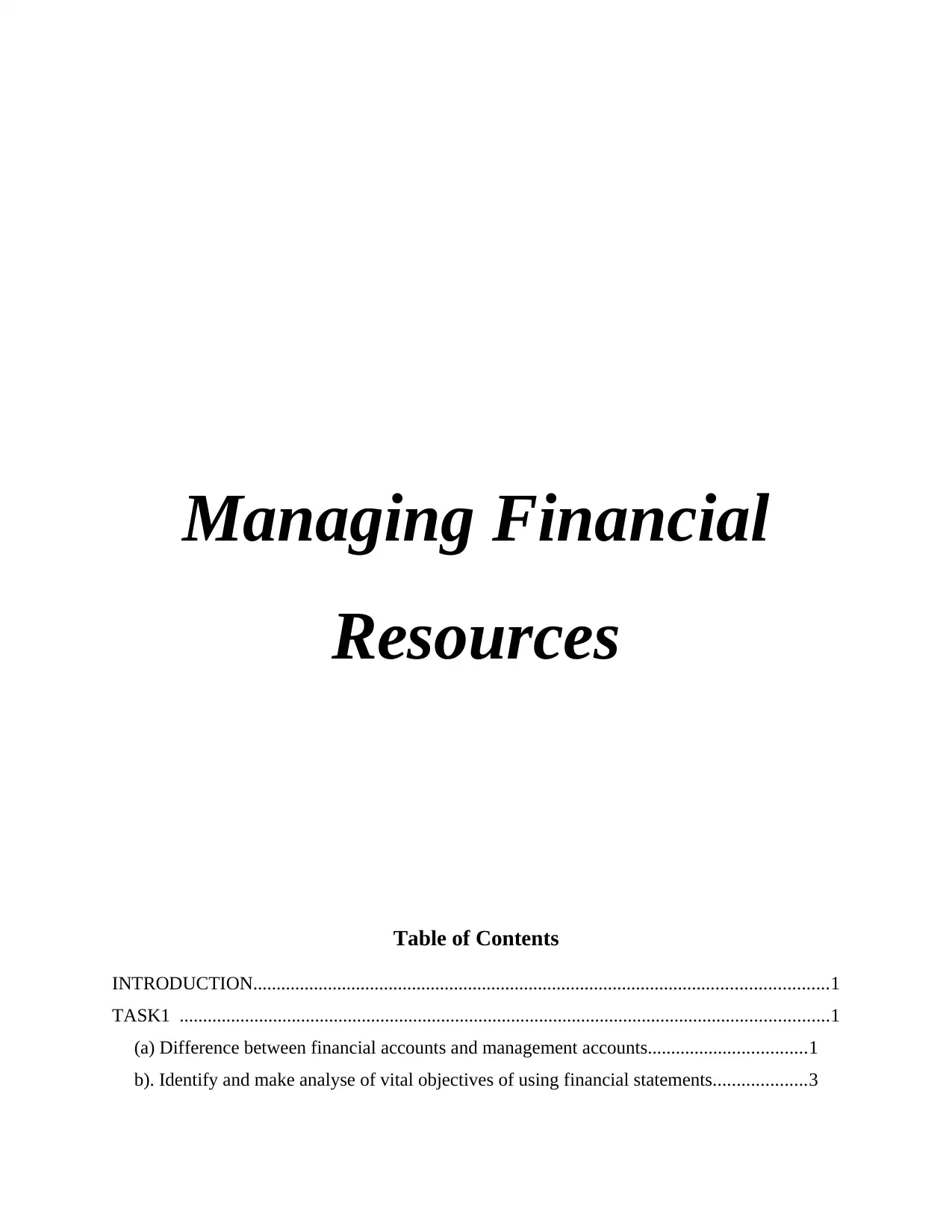
Managing Financial
Resources
Table of Contents
INTRODUCTION...........................................................................................................................1
TASK1 ...........................................................................................................................................1
(a) Difference between financial accounts and management accounts..................................1
b). Identify and make analyse of vital objectives of using financial statements....................3
Resources
Table of Contents
INTRODUCTION...........................................................................................................................1
TASK1 ...........................................................................................................................................1
(a) Difference between financial accounts and management accounts..................................1
b). Identify and make analyse of vital objectives of using financial statements....................3
Paraphrase This Document
Need a fresh take? Get an instant paraphrase of this document with our AI Paraphraser
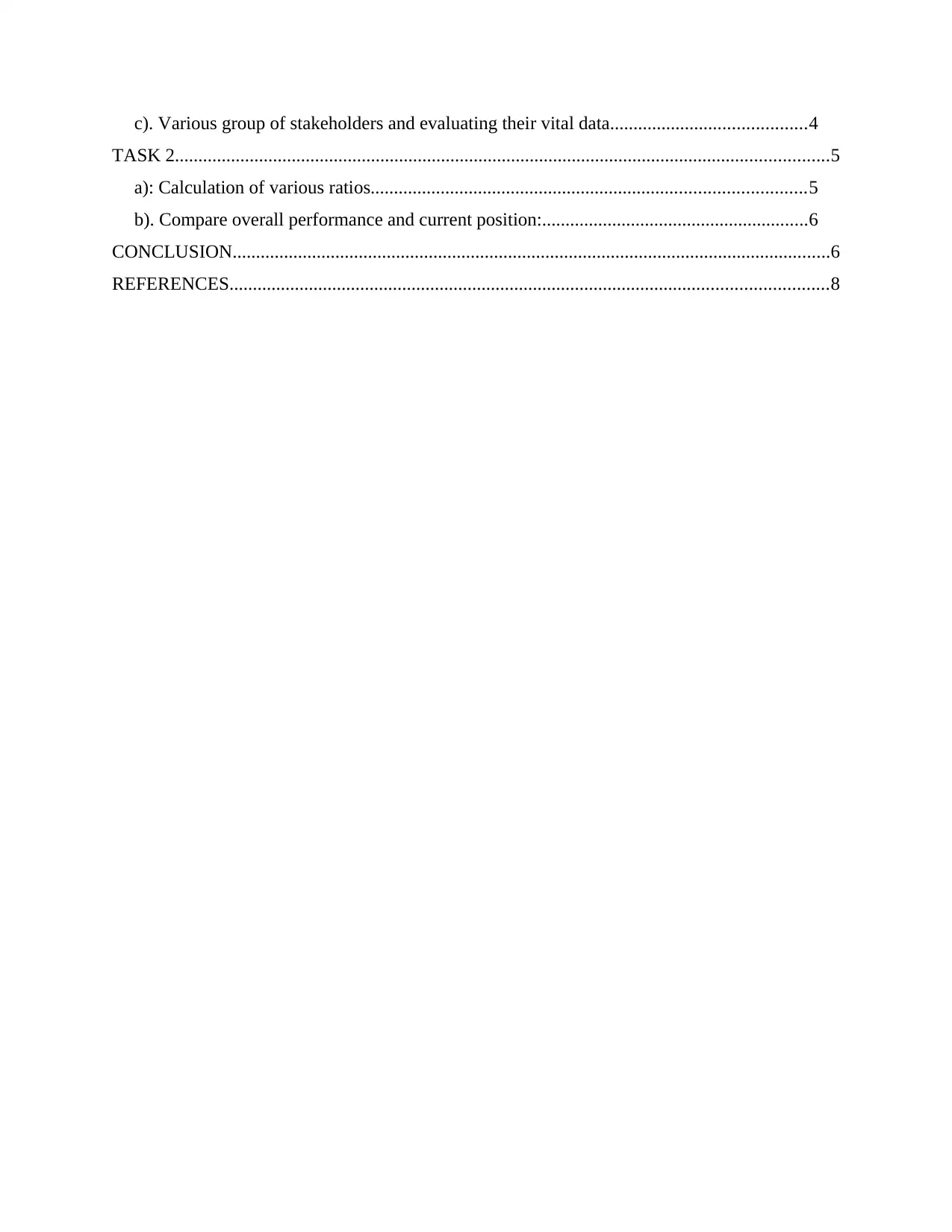
c). Various group of stakeholders and evaluating their vital data..........................................4
TASK 2............................................................................................................................................5
a): Calculation of various ratios.............................................................................................5
b). Compare overall performance and current position:.........................................................6
CONCLUSION................................................................................................................................6
REFERENCES................................................................................................................................8
TASK 2............................................................................................................................................5
a): Calculation of various ratios.............................................................................................5
b). Compare overall performance and current position:.........................................................6
CONCLUSION................................................................................................................................6
REFERENCES................................................................................................................................8
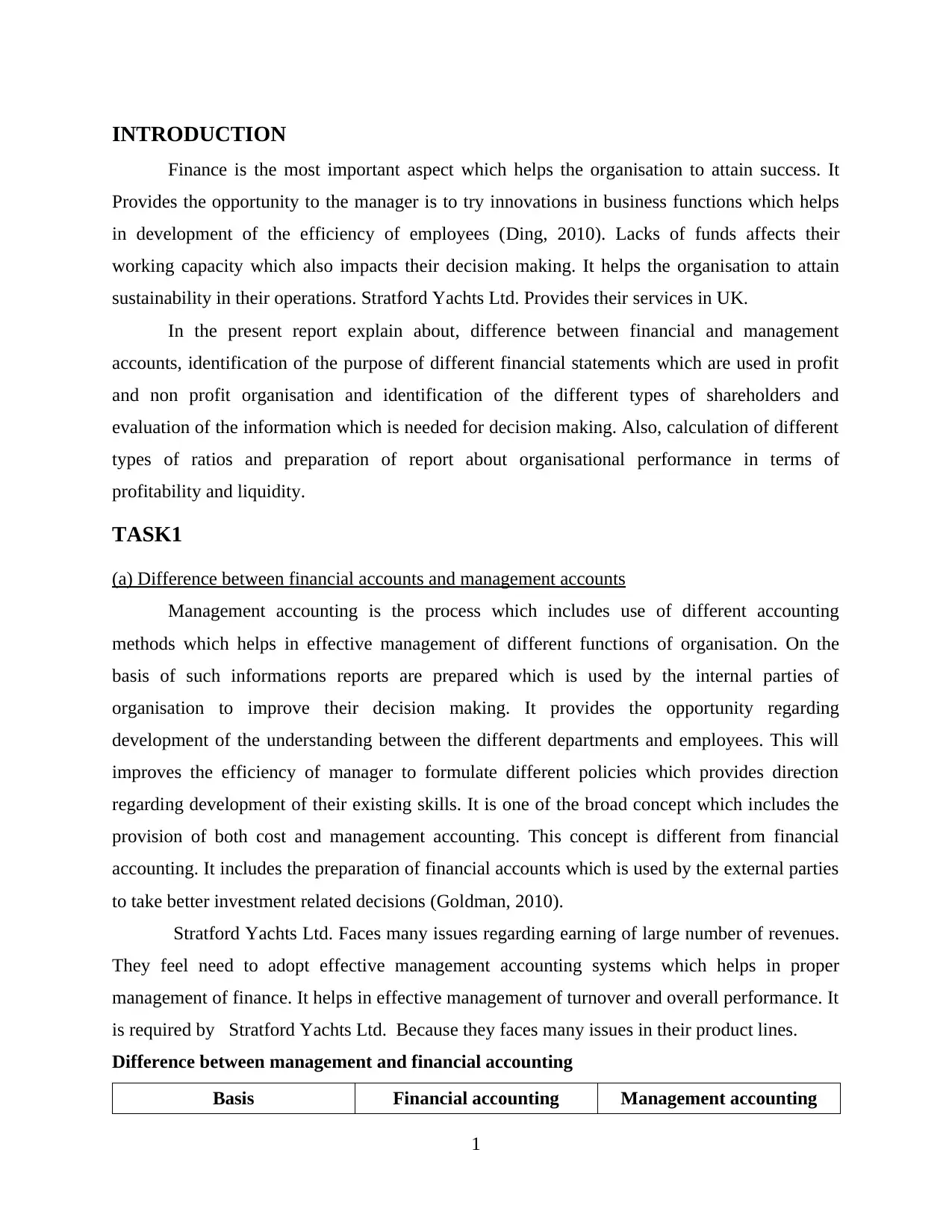
INTRODUCTION
Finance is the most important aspect which helps the organisation to attain success. It
Provides the opportunity to the manager is to try innovations in business functions which helps
in development of the efficiency of employees (Ding, 2010). Lacks of funds affects their
working capacity which also impacts their decision making. It helps the organisation to attain
sustainability in their operations. Stratford Yachts Ltd. Provides their services in UK.
In the present report explain about, difference between financial and management
accounts, identification of the purpose of different financial statements which are used in profit
and non profit organisation and identification of the different types of shareholders and
evaluation of the information which is needed for decision making. Also, calculation of different
types of ratios and preparation of report about organisational performance in terms of
profitability and liquidity.
TASK1
(a) Difference between financial accounts and management accounts
Management accounting is the process which includes use of different accounting
methods which helps in effective management of different functions of organisation. On the
basis of such informations reports are prepared which is used by the internal parties of
organisation to improve their decision making. It provides the opportunity regarding
development of the understanding between the different departments and employees. This will
improves the efficiency of manager to formulate different policies which provides direction
regarding development of their existing skills. It is one of the broad concept which includes the
provision of both cost and management accounting. This concept is different from financial
accounting. It includes the preparation of financial accounts which is used by the external parties
to take better investment related decisions (Goldman, 2010).
Stratford Yachts Ltd. Faces many issues regarding earning of large number of revenues.
They feel need to adopt effective management accounting systems which helps in proper
management of finance. It helps in effective management of turnover and overall performance. It
is required by Stratford Yachts Ltd. Because they faces many issues in their product lines.
Difference between management and financial accounting
Basis Financial accounting Management accounting
1
Finance is the most important aspect which helps the organisation to attain success. It
Provides the opportunity to the manager is to try innovations in business functions which helps
in development of the efficiency of employees (Ding, 2010). Lacks of funds affects their
working capacity which also impacts their decision making. It helps the organisation to attain
sustainability in their operations. Stratford Yachts Ltd. Provides their services in UK.
In the present report explain about, difference between financial and management
accounts, identification of the purpose of different financial statements which are used in profit
and non profit organisation and identification of the different types of shareholders and
evaluation of the information which is needed for decision making. Also, calculation of different
types of ratios and preparation of report about organisational performance in terms of
profitability and liquidity.
TASK1
(a) Difference between financial accounts and management accounts
Management accounting is the process which includes use of different accounting
methods which helps in effective management of different functions of organisation. On the
basis of such informations reports are prepared which is used by the internal parties of
organisation to improve their decision making. It provides the opportunity regarding
development of the understanding between the different departments and employees. This will
improves the efficiency of manager to formulate different policies which provides direction
regarding development of their existing skills. It is one of the broad concept which includes the
provision of both cost and management accounting. This concept is different from financial
accounting. It includes the preparation of financial accounts which is used by the external parties
to take better investment related decisions (Goldman, 2010).
Stratford Yachts Ltd. Faces many issues regarding earning of large number of revenues.
They feel need to adopt effective management accounting systems which helps in proper
management of finance. It helps in effective management of turnover and overall performance. It
is required by Stratford Yachts Ltd. Because they faces many issues in their product lines.
Difference between management and financial accounting
Basis Financial accounting Management accounting
1
⊘ This is a preview!⊘
Do you want full access?
Subscribe today to unlock all pages.

Trusted by 1+ million students worldwide
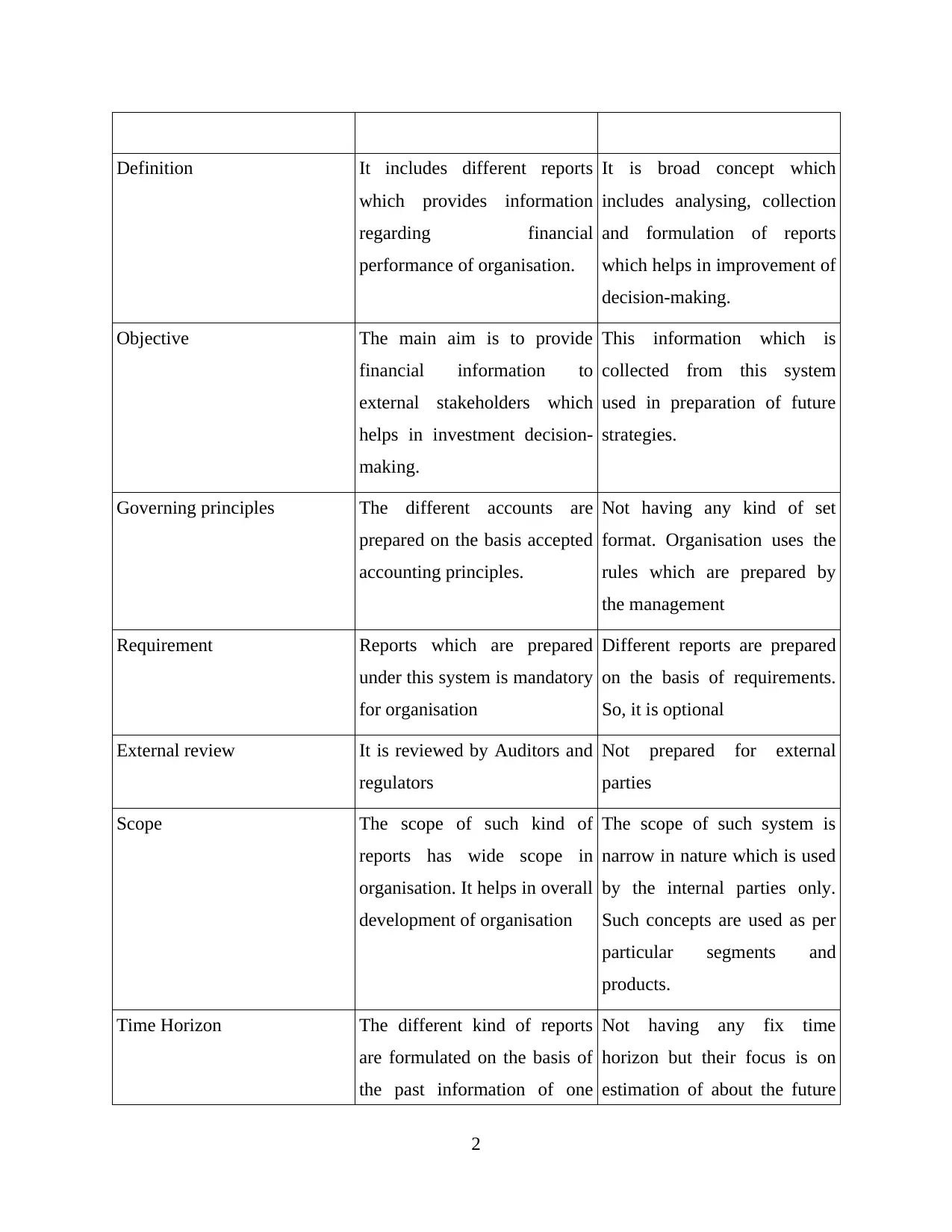
Definition It includes different reports
which provides information
regarding financial
performance of organisation.
It is broad concept which
includes analysing, collection
and formulation of reports
which helps in improvement of
decision-making.
Objective The main aim is to provide
financial information to
external stakeholders which
helps in investment decision-
making.
This information which is
collected from this system
used in preparation of future
strategies.
Governing principles The different accounts are
prepared on the basis accepted
accounting principles.
Not having any kind of set
format. Organisation uses the
rules which are prepared by
the management
Requirement Reports which are prepared
under this system is mandatory
for organisation
Different reports are prepared
on the basis of requirements.
So, it is optional
External review It is reviewed by Auditors and
regulators
Not prepared for external
parties
Scope The scope of such kind of
reports has wide scope in
organisation. It helps in overall
development of organisation
The scope of such system is
narrow in nature which is used
by the internal parties only.
Such concepts are used as per
particular segments and
products.
Time Horizon The different kind of reports
are formulated on the basis of
the past information of one
Not having any fix time
horizon but their focus is on
estimation of about the future
2
which provides information
regarding financial
performance of organisation.
It is broad concept which
includes analysing, collection
and formulation of reports
which helps in improvement of
decision-making.
Objective The main aim is to provide
financial information to
external stakeholders which
helps in investment decision-
making.
This information which is
collected from this system
used in preparation of future
strategies.
Governing principles The different accounts are
prepared on the basis accepted
accounting principles.
Not having any kind of set
format. Organisation uses the
rules which are prepared by
the management
Requirement Reports which are prepared
under this system is mandatory
for organisation
Different reports are prepared
on the basis of requirements.
So, it is optional
External review It is reviewed by Auditors and
regulators
Not prepared for external
parties
Scope The scope of such kind of
reports has wide scope in
organisation. It helps in overall
development of organisation
The scope of such system is
narrow in nature which is used
by the internal parties only.
Such concepts are used as per
particular segments and
products.
Time Horizon The different kind of reports
are formulated on the basis of
the past information of one
Not having any fix time
horizon but their focus is on
estimation of about the future
2
Paraphrase This Document
Need a fresh take? Get an instant paraphrase of this document with our AI Paraphraser
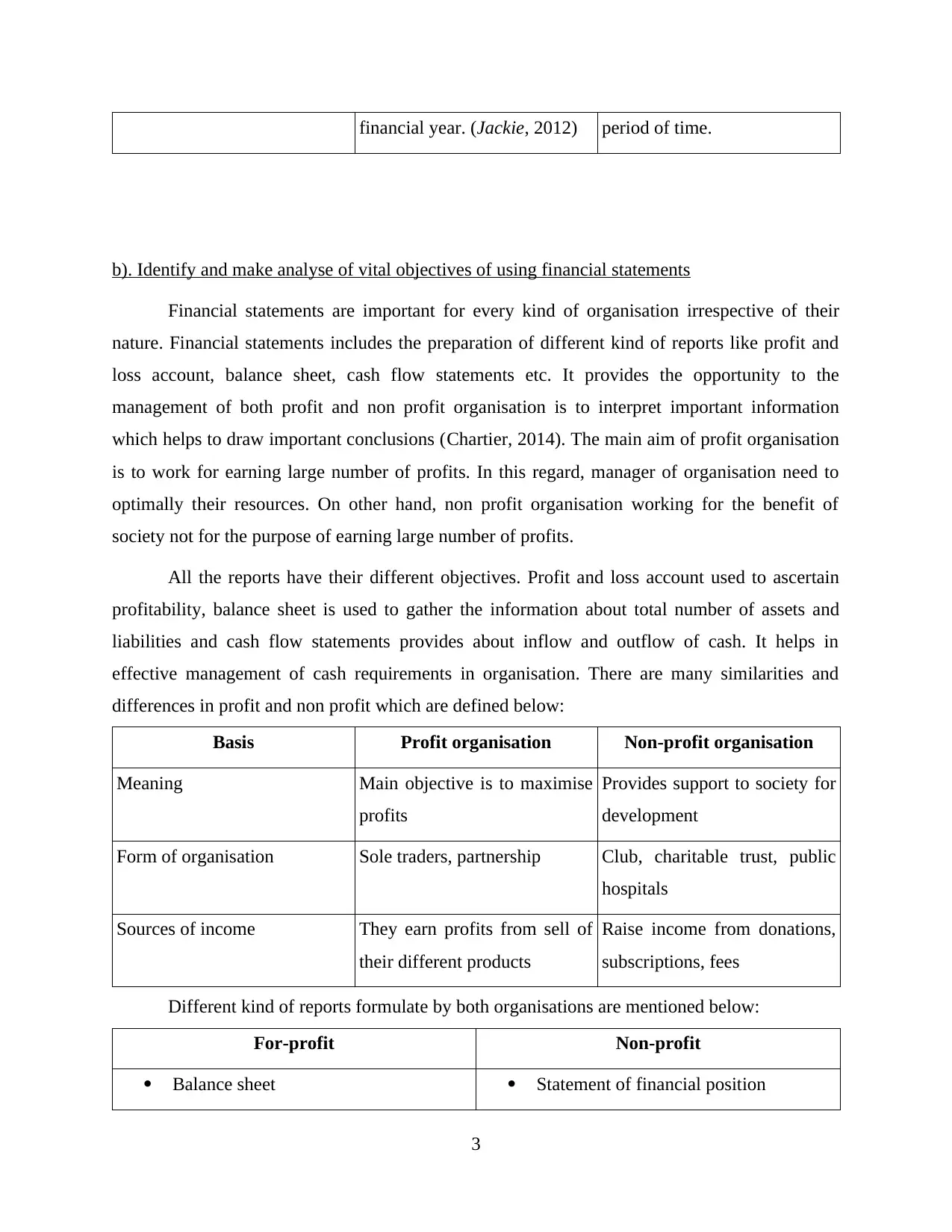
financial year. (Jackie, 2012) period of time.
b). Identify and make analyse of vital objectives of using financial statements
Financial statements are important for every kind of organisation irrespective of their
nature. Financial statements includes the preparation of different kind of reports like profit and
loss account, balance sheet, cash flow statements etc. It provides the opportunity to the
management of both profit and non profit organisation is to interpret important information
which helps to draw important conclusions (Chartier, 2014). The main aim of profit organisation
is to work for earning large number of profits. In this regard, manager of organisation need to
optimally their resources. On other hand, non profit organisation working for the benefit of
society not for the purpose of earning large number of profits.
All the reports have their different objectives. Profit and loss account used to ascertain
profitability, balance sheet is used to gather the information about total number of assets and
liabilities and cash flow statements provides about inflow and outflow of cash. It helps in
effective management of cash requirements in organisation. There are many similarities and
differences in profit and non profit which are defined below:
Basis Profit organisation Non-profit organisation
Meaning Main objective is to maximise
profits
Provides support to society for
development
Form of organisation Sole traders, partnership Club, charitable trust, public
hospitals
Sources of income They earn profits from sell of
their different products
Raise income from donations,
subscriptions, fees
Different kind of reports formulate by both organisations are mentioned below:
For-profit Non-profit
Balance sheet Statement of financial position
3
b). Identify and make analyse of vital objectives of using financial statements
Financial statements are important for every kind of organisation irrespective of their
nature. Financial statements includes the preparation of different kind of reports like profit and
loss account, balance sheet, cash flow statements etc. It provides the opportunity to the
management of both profit and non profit organisation is to interpret important information
which helps to draw important conclusions (Chartier, 2014). The main aim of profit organisation
is to work for earning large number of profits. In this regard, manager of organisation need to
optimally their resources. On other hand, non profit organisation working for the benefit of
society not for the purpose of earning large number of profits.
All the reports have their different objectives. Profit and loss account used to ascertain
profitability, balance sheet is used to gather the information about total number of assets and
liabilities and cash flow statements provides about inflow and outflow of cash. It helps in
effective management of cash requirements in organisation. There are many similarities and
differences in profit and non profit which are defined below:
Basis Profit organisation Non-profit organisation
Meaning Main objective is to maximise
profits
Provides support to society for
development
Form of organisation Sole traders, partnership Club, charitable trust, public
hospitals
Sources of income They earn profits from sell of
their different products
Raise income from donations,
subscriptions, fees
Different kind of reports formulate by both organisations are mentioned below:
For-profit Non-profit
Balance sheet Statement of financial position
3
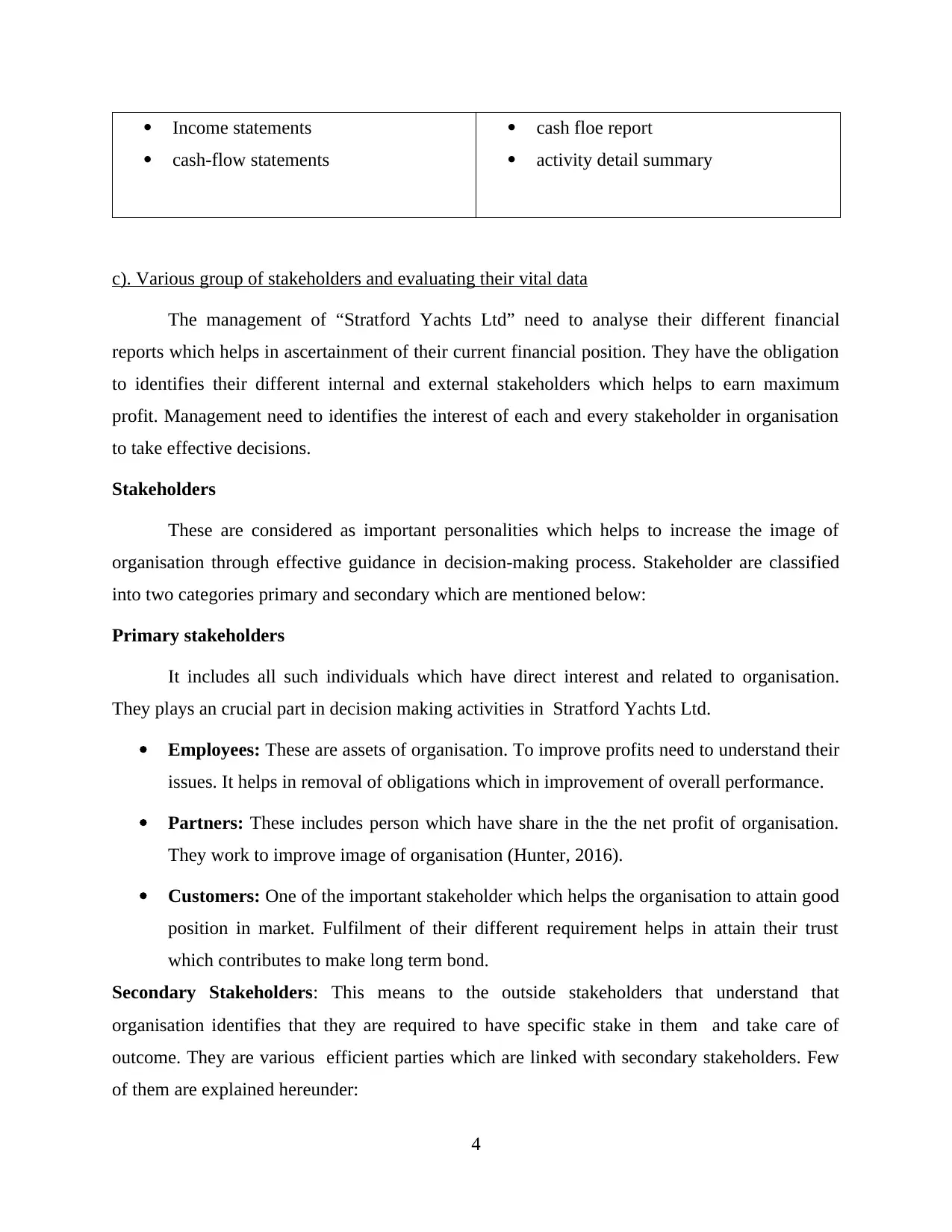
Income statements
cash-flow statements
cash floe report
activity detail summary
c). Various group of stakeholders and evaluating their vital data
The management of “Stratford Yachts Ltd” need to analyse their different financial
reports which helps in ascertainment of their current financial position. They have the obligation
to identifies their different internal and external stakeholders which helps to earn maximum
profit. Management need to identifies the interest of each and every stakeholder in organisation
to take effective decisions.
Stakeholders
These are considered as important personalities which helps to increase the image of
organisation through effective guidance in decision-making process. Stakeholder are classified
into two categories primary and secondary which are mentioned below:
Primary stakeholders
It includes all such individuals which have direct interest and related to organisation.
They plays an crucial part in decision making activities in Stratford Yachts Ltd.
Employees: These are assets of organisation. To improve profits need to understand their
issues. It helps in removal of obligations which in improvement of overall performance.
Partners: These includes person which have share in the the net profit of organisation.
They work to improve image of organisation (Hunter, 2016).
Customers: One of the important stakeholder which helps the organisation to attain good
position in market. Fulfilment of their different requirement helps in attain their trust
which contributes to make long term bond.
Secondary Stakeholders: This means to the outside stakeholders that understand that
organisation identifies that they are required to have specific stake in them and take care of
outcome. They are various efficient parties which are linked with secondary stakeholders. Few
of them are explained hereunder:
4
cash-flow statements
cash floe report
activity detail summary
c). Various group of stakeholders and evaluating their vital data
The management of “Stratford Yachts Ltd” need to analyse their different financial
reports which helps in ascertainment of their current financial position. They have the obligation
to identifies their different internal and external stakeholders which helps to earn maximum
profit. Management need to identifies the interest of each and every stakeholder in organisation
to take effective decisions.
Stakeholders
These are considered as important personalities which helps to increase the image of
organisation through effective guidance in decision-making process. Stakeholder are classified
into two categories primary and secondary which are mentioned below:
Primary stakeholders
It includes all such individuals which have direct interest and related to organisation.
They plays an crucial part in decision making activities in Stratford Yachts Ltd.
Employees: These are assets of organisation. To improve profits need to understand their
issues. It helps in removal of obligations which in improvement of overall performance.
Partners: These includes person which have share in the the net profit of organisation.
They work to improve image of organisation (Hunter, 2016).
Customers: One of the important stakeholder which helps the organisation to attain good
position in market. Fulfilment of their different requirement helps in attain their trust
which contributes to make long term bond.
Secondary Stakeholders: This means to the outside stakeholders that understand that
organisation identifies that they are required to have specific stake in them and take care of
outcome. They are various efficient parties which are linked with secondary stakeholders. Few
of them are explained hereunder:
4
⊘ This is a preview!⊘
Do you want full access?
Subscribe today to unlock all pages.

Trusted by 1+ million students worldwide
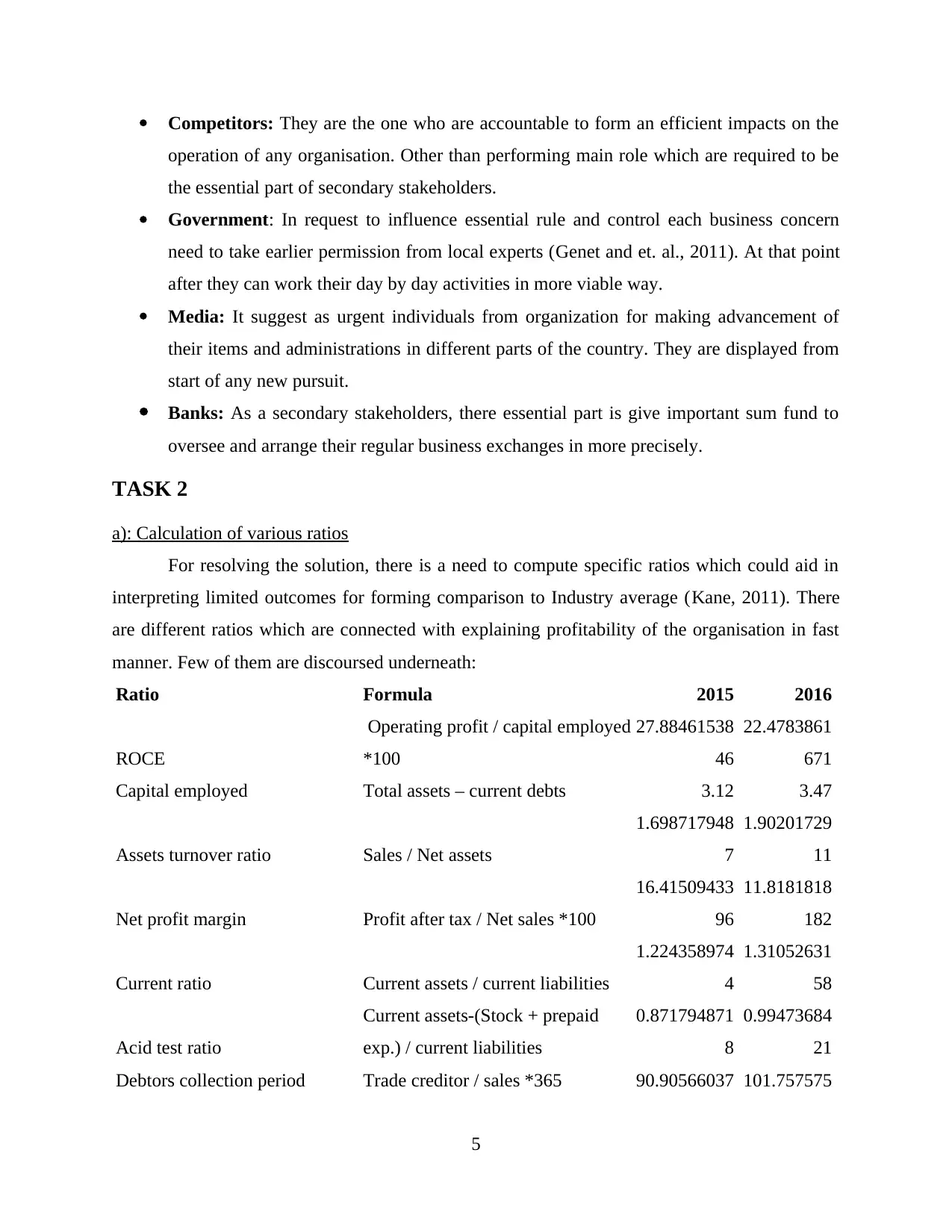
Competitors: They are the one who are accountable to form an efficient impacts on the
operation of any organisation. Other than performing main role which are required to be
the essential part of secondary stakeholders.
Government: In request to influence essential rule and control each business concern
need to take earlier permission from local experts (Genet and et. al., 2011). At that point
after they can work their day by day activities in more viable way.
Media: It suggest as urgent individuals from organization for making advancement of
their items and administrations in different parts of the country. They are displayed from
start of any new pursuit.
Banks: As a secondary stakeholders, there essential part is give important sum fund to
oversee and arrange their regular business exchanges in more precisely.
TASK 2
a): Calculation of various ratios
For resolving the solution, there is a need to compute specific ratios which could aid in
interpreting limited outcomes for forming comparison to Industry average (Kane, 2011). There
are different ratios which are connected with explaining profitability of the organisation in fast
manner. Few of them are discoursed underneath:
Ratio Formula 2015 2016
ROCE
Operating profit / capital employed
*100
27.88461538
46
22.4783861
671
Capital employed Total assets – current debts 3.12 3.47
Assets turnover ratio Sales / Net assets
1.698717948
7
1.90201729
11
Net profit margin Profit after tax / Net sales *100
16.41509433
96
11.8181818
182
Current ratio Current assets / current liabilities
1.224358974
4
1.31052631
58
Acid test ratio
Current assets-(Stock + prepaid
exp.) / current liabilities
0.871794871
8
0.99473684
21
Debtors collection period Trade creditor / sales *365 90.90566037 101.757575
5
operation of any organisation. Other than performing main role which are required to be
the essential part of secondary stakeholders.
Government: In request to influence essential rule and control each business concern
need to take earlier permission from local experts (Genet and et. al., 2011). At that point
after they can work their day by day activities in more viable way.
Media: It suggest as urgent individuals from organization for making advancement of
their items and administrations in different parts of the country. They are displayed from
start of any new pursuit.
Banks: As a secondary stakeholders, there essential part is give important sum fund to
oversee and arrange their regular business exchanges in more precisely.
TASK 2
a): Calculation of various ratios
For resolving the solution, there is a need to compute specific ratios which could aid in
interpreting limited outcomes for forming comparison to Industry average (Kane, 2011). There
are different ratios which are connected with explaining profitability of the organisation in fast
manner. Few of them are discoursed underneath:
Ratio Formula 2015 2016
ROCE
Operating profit / capital employed
*100
27.88461538
46
22.4783861
671
Capital employed Total assets – current debts 3.12 3.47
Assets turnover ratio Sales / Net assets
1.698717948
7
1.90201729
11
Net profit margin Profit after tax / Net sales *100
16.41509433
96
11.8181818
182
Current ratio Current assets / current liabilities
1.224358974
4
1.31052631
58
Acid test ratio
Current assets-(Stock + prepaid
exp.) / current liabilities
0.871794871
8
0.99473684
21
Debtors collection period Trade creditor / sales *365 90.90566037 101.757575
5
Paraphrase This Document
Need a fresh take? Get an instant paraphrase of this document with our AI Paraphraser
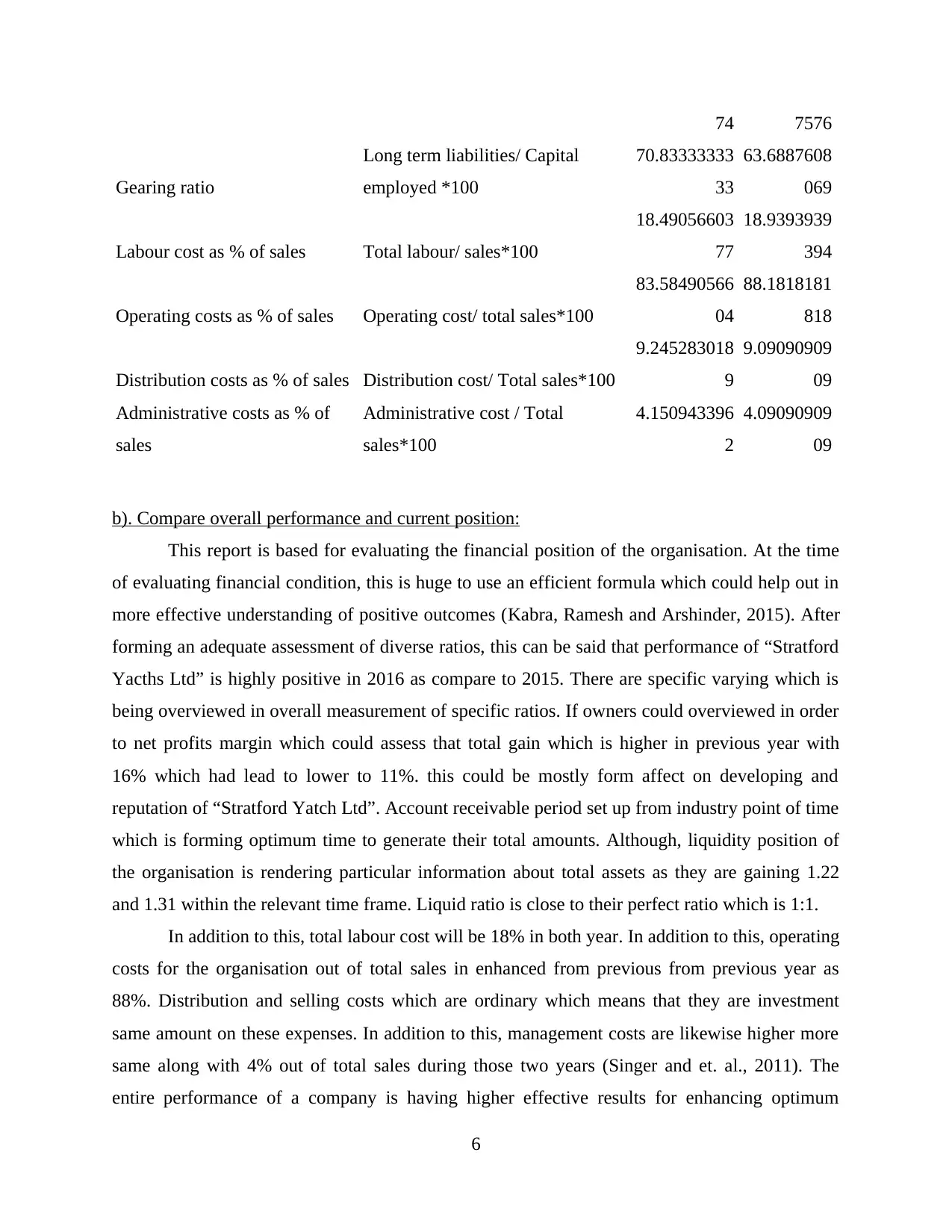
74 7576
Gearing ratio
Long term liabilities/ Capital
employed *100
70.83333333
33
63.6887608
069
Labour cost as % of sales Total labour/ sales*100
18.49056603
77
18.9393939
394
Operating costs as % of sales Operating cost/ total sales*100
83.58490566
04
88.1818181
818
Distribution costs as % of sales Distribution cost/ Total sales*100
9.245283018
9
9.09090909
09
Administrative costs as % of
sales
Administrative cost / Total
sales*100
4.150943396
2
4.09090909
09
b). Compare overall performance and current position:
This report is based for evaluating the financial position of the organisation. At the time
of evaluating financial condition, this is huge to use an efficient formula which could help out in
more effective understanding of positive outcomes (Kabra, Ramesh and Arshinder, 2015). After
forming an adequate assessment of diverse ratios, this can be said that performance of “Stratford
Yacths Ltd” is highly positive in 2016 as compare to 2015. There are specific varying which is
being overviewed in overall measurement of specific ratios. If owners could overviewed in order
to net profits margin which could assess that total gain which is higher in previous year with
16% which had lead to lower to 11%. this could be mostly form affect on developing and
reputation of “Stratford Yatch Ltd”. Account receivable period set up from industry point of time
which is forming optimum time to generate their total amounts. Although, liquidity position of
the organisation is rendering particular information about total assets as they are gaining 1.22
and 1.31 within the relevant time frame. Liquid ratio is close to their perfect ratio which is 1:1.
In addition to this, total labour cost will be 18% in both year. In addition to this, operating
costs for the organisation out of total sales in enhanced from previous from previous year as
88%. Distribution and selling costs which are ordinary which means that they are investment
same amount on these expenses. In addition to this, management costs are likewise higher more
same along with 4% out of total sales during those two years (Singer and et. al., 2011). The
entire performance of a company is having higher effective results for enhancing optimum
6
Gearing ratio
Long term liabilities/ Capital
employed *100
70.83333333
33
63.6887608
069
Labour cost as % of sales Total labour/ sales*100
18.49056603
77
18.9393939
394
Operating costs as % of sales Operating cost/ total sales*100
83.58490566
04
88.1818181
818
Distribution costs as % of sales Distribution cost/ Total sales*100
9.245283018
9
9.09090909
09
Administrative costs as % of
sales
Administrative cost / Total
sales*100
4.150943396
2
4.09090909
09
b). Compare overall performance and current position:
This report is based for evaluating the financial position of the organisation. At the time
of evaluating financial condition, this is huge to use an efficient formula which could help out in
more effective understanding of positive outcomes (Kabra, Ramesh and Arshinder, 2015). After
forming an adequate assessment of diverse ratios, this can be said that performance of “Stratford
Yacths Ltd” is highly positive in 2016 as compare to 2015. There are specific varying which is
being overviewed in overall measurement of specific ratios. If owners could overviewed in order
to net profits margin which could assess that total gain which is higher in previous year with
16% which had lead to lower to 11%. this could be mostly form affect on developing and
reputation of “Stratford Yatch Ltd”. Account receivable period set up from industry point of time
which is forming optimum time to generate their total amounts. Although, liquidity position of
the organisation is rendering particular information about total assets as they are gaining 1.22
and 1.31 within the relevant time frame. Liquid ratio is close to their perfect ratio which is 1:1.
In addition to this, total labour cost will be 18% in both year. In addition to this, operating
costs for the organisation out of total sales in enhanced from previous from previous year as
88%. Distribution and selling costs which are ordinary which means that they are investment
same amount on these expenses. In addition to this, management costs are likewise higher more
same along with 4% out of total sales during those two years (Singer and et. al., 2011). The
entire performance of a company is having higher effective results for enhancing optimum
6
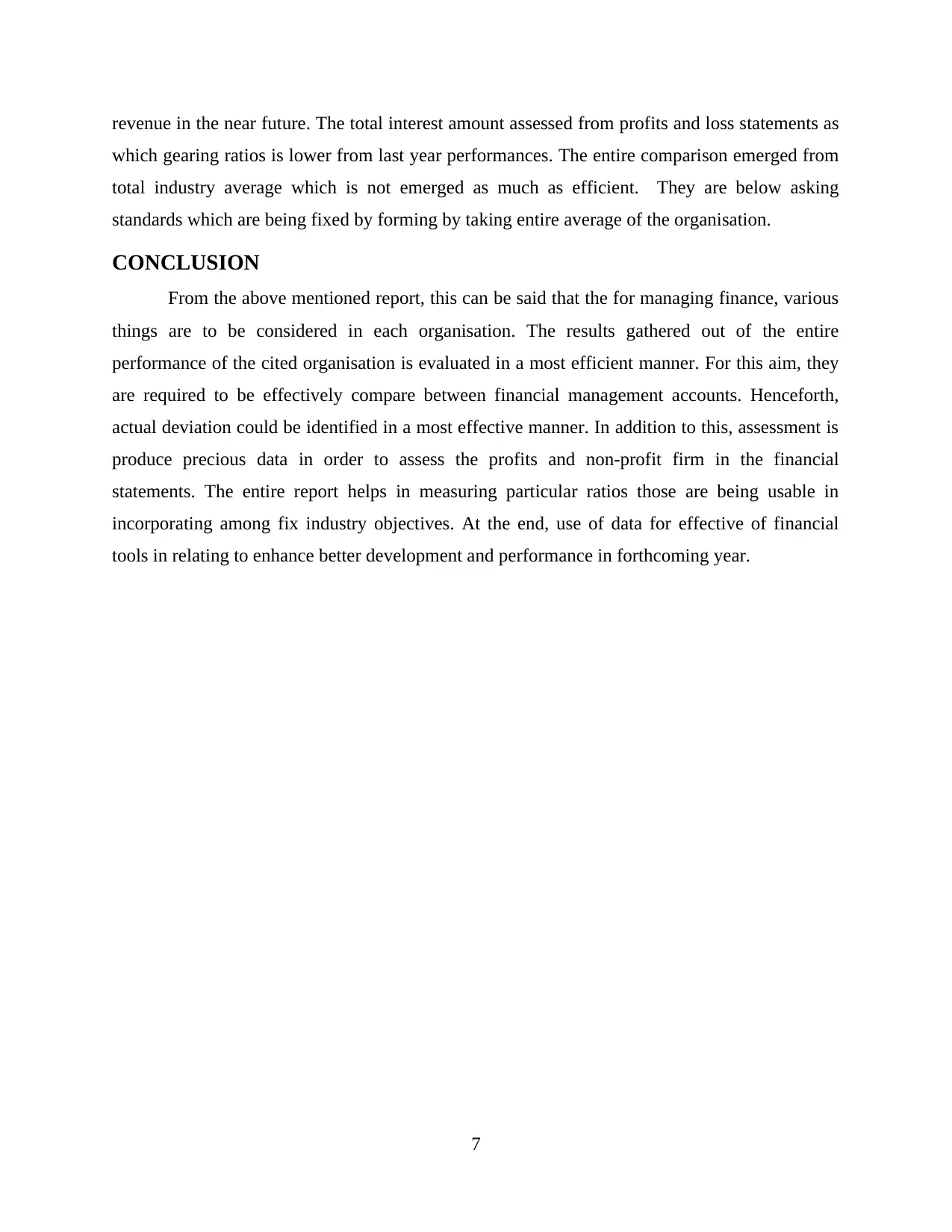
revenue in the near future. The total interest amount assessed from profits and loss statements as
which gearing ratios is lower from last year performances. The entire comparison emerged from
total industry average which is not emerged as much as efficient. They are below asking
standards which are being fixed by forming by taking entire average of the organisation.
CONCLUSION
From the above mentioned report, this can be said that the for managing finance, various
things are to be considered in each organisation. The results gathered out of the entire
performance of the cited organisation is evaluated in a most efficient manner. For this aim, they
are required to be effectively compare between financial management accounts. Henceforth,
actual deviation could be identified in a most effective manner. In addition to this, assessment is
produce precious data in order to assess the profits and non-profit firm in the financial
statements. The entire report helps in measuring particular ratios those are being usable in
incorporating among fix industry objectives. At the end, use of data for effective of financial
tools in relating to enhance better development and performance in forthcoming year.
7
which gearing ratios is lower from last year performances. The entire comparison emerged from
total industry average which is not emerged as much as efficient. They are below asking
standards which are being fixed by forming by taking entire average of the organisation.
CONCLUSION
From the above mentioned report, this can be said that the for managing finance, various
things are to be considered in each organisation. The results gathered out of the entire
performance of the cited organisation is evaluated in a most efficient manner. For this aim, they
are required to be effectively compare between financial management accounts. Henceforth,
actual deviation could be identified in a most effective manner. In addition to this, assessment is
produce precious data in order to assess the profits and non-profit firm in the financial
statements. The entire report helps in measuring particular ratios those are being usable in
incorporating among fix industry objectives. At the end, use of data for effective of financial
tools in relating to enhance better development and performance in forthcoming year.
7
⊘ This is a preview!⊘
Do you want full access?
Subscribe today to unlock all pages.

Trusted by 1+ million students worldwide
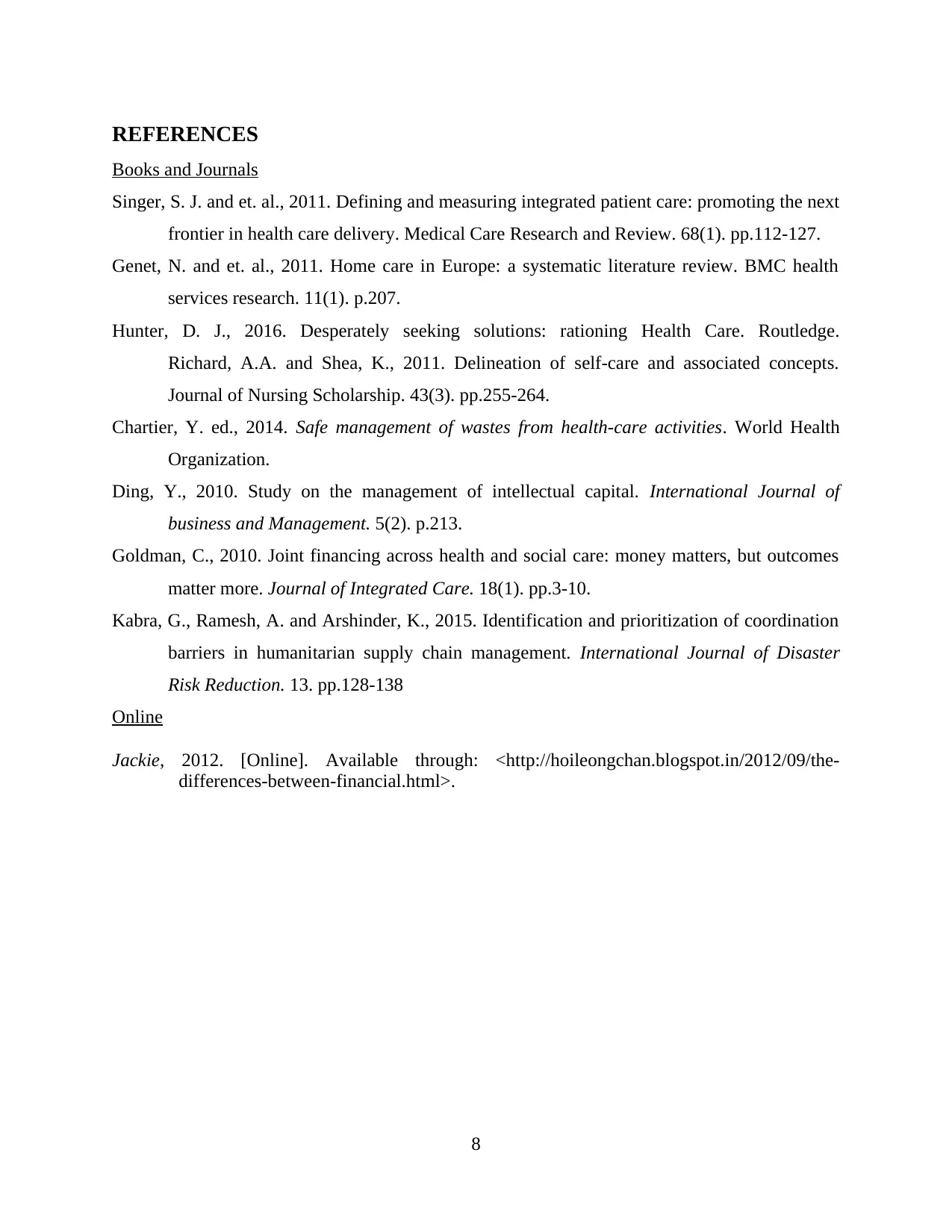
REFERENCES
Books and Journals
Singer, S. J. and et. al., 2011. Defining and measuring integrated patient care: promoting the next
frontier in health care delivery. Medical Care Research and Review. 68(1). pp.112-127.
Genet, N. and et. al., 2011. Home care in Europe: a systematic literature review. BMC health
services research. 11(1). p.207.
Hunter, D. J., 2016. Desperately seeking solutions: rationing Health Care. Routledge.
Richard, A.A. and Shea, K., 2011. Delineation of self‐care and associated concepts.
Journal of Nursing Scholarship. 43(3). pp.255-264.
Chartier, Y. ed., 2014. Safe management of wastes from health-care activities. World Health
Organization.
Ding, Y., 2010. Study on the management of intellectual capital. International Journal of
business and Management. 5(2). p.213.
Goldman, C., 2010. Joint financing across health and social care: money matters, but outcomes
matter more. Journal of Integrated Care. 18(1). pp.3-10.
Kabra, G., Ramesh, A. and Arshinder, K., 2015. Identification and prioritization of coordination
barriers in humanitarian supply chain management. International Journal of Disaster
Risk Reduction. 13. pp.128-138
Online
Jackie, 2012. [Online]. Available through: <http://hoileongchan.blogspot.in/2012/09/the-
differences-between-financial.html>.
8
Books and Journals
Singer, S. J. and et. al., 2011. Defining and measuring integrated patient care: promoting the next
frontier in health care delivery. Medical Care Research and Review. 68(1). pp.112-127.
Genet, N. and et. al., 2011. Home care in Europe: a systematic literature review. BMC health
services research. 11(1). p.207.
Hunter, D. J., 2016. Desperately seeking solutions: rationing Health Care. Routledge.
Richard, A.A. and Shea, K., 2011. Delineation of self‐care and associated concepts.
Journal of Nursing Scholarship. 43(3). pp.255-264.
Chartier, Y. ed., 2014. Safe management of wastes from health-care activities. World Health
Organization.
Ding, Y., 2010. Study on the management of intellectual capital. International Journal of
business and Management. 5(2). p.213.
Goldman, C., 2010. Joint financing across health and social care: money matters, but outcomes
matter more. Journal of Integrated Care. 18(1). pp.3-10.
Kabra, G., Ramesh, A. and Arshinder, K., 2015. Identification and prioritization of coordination
barriers in humanitarian supply chain management. International Journal of Disaster
Risk Reduction. 13. pp.128-138
Online
Jackie, 2012. [Online]. Available through: <http://hoileongchan.blogspot.in/2012/09/the-
differences-between-financial.html>.
8
1 out of 10
Related Documents
Your All-in-One AI-Powered Toolkit for Academic Success.
+13062052269
info@desklib.com
Available 24*7 on WhatsApp / Email
![[object Object]](/_next/static/media/star-bottom.7253800d.svg)
Unlock your academic potential
Copyright © 2020–2025 A2Z Services. All Rights Reserved. Developed and managed by ZUCOL.





